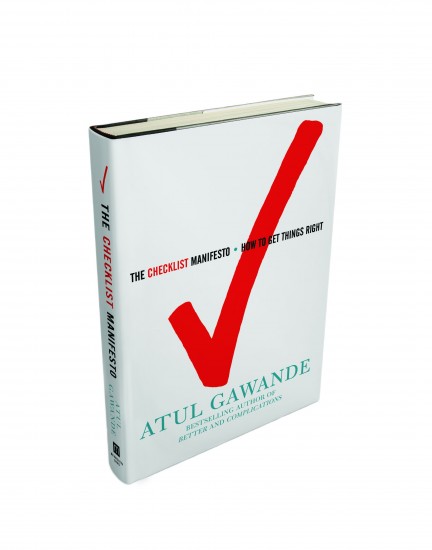In Praise of Checklists
 A little more than a year ago, checklists were all the rage thanks to the publication of Atul Gawande’s The Checklist Manifesto.1 Gawande was advocating for the increased use of checklists in medical care because studies had demonstrated that checklists—in intensive care units, in operating rooms, in airplane cockpits—saved lives.
A little more than a year ago, checklists were all the rage thanks to the publication of Atul Gawande’s The Checklist Manifesto.1 Gawande was advocating for the increased use of checklists in medical care because studies had demonstrated that checklists—in intensive care units, in operating rooms, in airplane cockpits—saved lives.
Gawande’s argument shouldn’t have been so novel that it got the media attention it got; frankly, it’s more than a little incredible that hospitals didn’t make checklists a part of routine medical care years ago. I am sure (and Gawande intimates as much), that pride is a major reason they haven’t. Doctors’ and nurses’ professional training is long and intense. When G was in the NICU, I watched the neonatology residents and fellows run gauntlets set by the staff doctors. Day in and day out, there was little they were allowed not to know about their patients—test results, hourly vital signs, treatment plans, everything—even about G, who was relatively healthy throughout his two months there. I was and still am grateful for that training. I believe G is healthy and happy today because of it. But when I think of the time and effort those doctors invested in their work, I see a trap. How easy it would be for their professional identities to become wrapped up in always knowing their patients and the routine and emergency actions to take. To even suggest that perhaps they forget—as the introduction of a checklist might do—could be construed as an affront to the profession.
And a checklist is a document of humility. To need one is to recognize that you are fallible, that you might forget to remove all surgical instruments from a man’s chest, that you might forget to lower the landing gear of the plane you’re piloting, that you might forget, period. I have known people who would have a difficult time admitting they could make such mistakes.
I’m not one of those people. I make mistakes all the time. Fortunately, I’m an editor, and there are precious few occasions for my mistakes to have life-or-death consequences. Moreover, like most editors, I usually have chances to correct the faults of my first editions.2 That said, I try not to let my mistakes out into the world. That’s why I make checklists.
 I was thinking about all this last night as I was running a checklist on a manuscript I was preparing to send to designers. The manuscript was long—more than 38,000 words—and I had already been worrying over it for ten hours straight (and weeks before that). I had read it through several times, and I was tired. I wanted to call the thing finished and go home for supper. But the checklist had lines yet unchecked, so I stuck it out long enough to mark them off. I am glad I did. Most of the errors I found were minor—a transposed number here, an incorrectly applied style there—but others were such that I would have been setting the designers (and later, myself) up for some nasty headaches had they gone uncaught. As I was fixing the errors, I realized that the checklist hadn’t undermined my work—far from it. It made me a better editor.
I was thinking about all this last night as I was running a checklist on a manuscript I was preparing to send to designers. The manuscript was long—more than 38,000 words—and I had already been worrying over it for ten hours straight (and weeks before that). I had read it through several times, and I was tired. I wanted to call the thing finished and go home for supper. But the checklist had lines yet unchecked, so I stuck it out long enough to mark them off. I am glad I did. Most of the errors I found were minor—a transposed number here, an incorrectly applied style there—but others were such that I would have been setting the designers (and later, myself) up for some nasty headaches had they gone uncaught. As I was fixing the errors, I realized that the checklist hadn’t undermined my work—far from it. It made me a better editor.
1 The Checklist Manifesto was anticipated by this 2007 New Yorker essay. It represents Gawande’s point well.
2 An editor’s life is to work a text ever closer to the limit of perfection. But we work in the library of Babel; the limit never comes.


